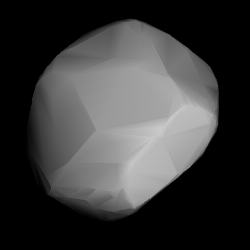
Alexandra is a carbonaceous asteroid from the intermediate asteroid belt, approximately 155 kilometers in diameter. It was discovered by German-French astronomer Hermann Goldschmidt on 10 September 1858, and named after the German explorer Alexander von Humboldt; it was the first asteroid to be named after a male.

Eurynome is a quite large and bright main-belt asteroid composed of silicate rock. Eurynome was discovered by J. C. Watson on September 14, 1863. It was his first asteroid discovery and is named after one of the many Eurynomes in Greek mythology. It is orbiting the Sun with a period of 3.82 years and has a rotation period of six hours. This is the eponymous member of a proposed asteroid family with at least 43 members, including 477 Italia and 917 Lyka.

Nemesis is a large 180 km main-belt asteroid, of carbonaceous composition. It rotates rather slowly, taking about 78 hours to complete one rotation. Nemesis is the largest member of the Nemesian asteroid family bearing its name. It was discovered by J. C. Watson on 25 November 1872, and named after Nemesis, the goddess of retribution in Greek mythology.

Ophelia is a large, dark Themistian asteroid that was discovered by French astronomer Alphonse Borrelly on 13 January 1877, and named after Ophelia in Shakespeare's Hamlet.

Asterope is a large main-belt asteroid that was discovered on 11 May 1883, by French astronomer Alphonse Borrelly at Marseille Observatory in Marseille, France. The asteroid was named after Asterope, one of the Pleiades.

Hypatia is a very large main-belt asteroid that was discovered by Russian astronomer Viktor Knorre on July 1, 1884, in Berlin. It was the third of his four asteroid discoveries. The name was given in honour of philosopher Hypatia of Alexandria. Based upon the spectrum, it is classified as a C-type asteroid and is probably composed of primitive carbonaceous material. Like many asteroids of this type, its surface is very dark in colour.

Bettina is a large main belt asteroid that was discovered by Austrian astronomer Johann Palisa on September 3, 1885, in Vienna. It was named in honour of Baroness Bettina von Rothschild, wife of Baron Albert von Rothschild who had bought the naming rights for £50. Based upon the spectrum, it is classified as an M-type asteroid.

Lucretia is an asteroid belonging to the Flora family in the Main Belt. It was discovered by Austrian astronomer Johann Palisa on 31 October 1888 in Vienna, and is named after the middle name of Caroline Herschel, one of the first female astronomers. Light curves of this asteroid show a synodic rotation period of 4.349±0.001 h with an amplitude of 0.3–0.4 magnitude. The spin axis appears nearly perpendicular to the ecliptic.

Constantia is a stony background asteroid from the inner region of the asteroid belt, approximately 6.5 kilometers in diameter. It was discovered by Austrian astronomer Johann Palisa at the Vienna Observatory on 4 September 1891. The asteroid is a member of the Flora family. It is spinning with a rotation period of 5.345±0.003 h and shows a brightness variation of 0.57±0.2 in magnitude.

360 Carlova is a very large main-belt asteroid. It is classified as a C-type asteroid and is probably composed of carbonaceous material. The asteroid has a convex, roughly ellipsoid shape. The sidereal rotation period is 6.1873 hours with an axis of rotation along the ecliptic coordinates (l, b) = (95°±3°, 40°±1°). It was discovered by Auguste Charlois on 11 March 1893 in Nice.

Geometria is a main belt asteroid that was discovered by French astronomer Auguste Charlois on 18 September 1893 in Nice, France. It is classified as an S-type asteroid.

Aspasia is a large main-belt asteroid that was discovered by French astronomer Auguste Charlois on 9 December 1895 in Nice. It is classified as a CX-type asteroid.
Chloris is a very large main-belt asteroid that was discovered by Auguste Charlois on January 7, 1896, in Nice. It is classified as a C-type asteroid and is probably composed of primitive carbonaceous material. The spectrum of the asteroid displays evidence of aqueous alteration. It is the namesake of the Chloris family of asteroids.
Italia is a main-belt asteroid that was discovered on 23 August 1901 by Italian astronomer Luigi Carnera at Heidelberg.
674 Rachele is a minor planet orbiting the Sun. It was discovered by Wilhelm Lorenz on 28 October 1908 in Heidelberg, and was named by orbit computer Emilio Bianchi after his wife. This is classified as an S-type asteroid, indicating a stony composition.
700 Auravictrix is an asteroid belonging to the Flora family in the Main Belt. Its diameter is about 15 km and it has an albedo of 0.246. Its rotation period is 6.075 hours.

776 Berbericia is a minor planet orbiting the Sun. A main-belt C-type asteroid, it was discovered on 24 January 1914 by astronomer Adam Massinger at Heidelberg Observatory in southwest Germany. It was named by Max Wolf in honor of Adolf Berberich (1861–1920), a German astronomer. The spectra of the asteroid displays evidence of aqueous alteration.

800 Kressmannia is an S-type asteroid belonging to the Flora family in the Main Belt. Its rotation period is 4.464 hours.
841 Arabella is an asteroid belonging to the Flora family in the Main Belt. Its rotation period is 3.39 hours. It is named after the title character from Richard Strauss' opera Arabella.
905 Universitas is an S-type asteroid orbiting in the Main belt as part of the Flora family. Its diameter is about 21 km and it has an albedo of 0.085. Its rotation period is approximately 14.2 hours.














